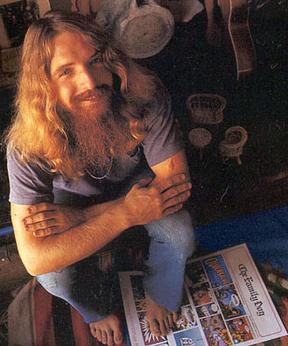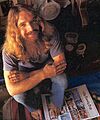Rick Griffin facts for kids
Quick facts for kids Rick Griffin |
|
|---|---|
 |
|
| Born | Richard Alden Griffin June 18, 1944 Palos Verdes, California, U.S. |
| Died | August 18, 1991 (aged 47) Petaluma, California, U.S. |
| Nationality | American |
| Area(s) | Cartoonist |
|
Notable works
|
Flying Eyeball, Aoxomoxoa, Pow Wow: A Gathering of the Tribes |
| Awards | Inkpot Award (1976) |
Richard Alden "Rick" Griffin (June 18, 1944 – August 18, 1991) was an American artist. He was one of the top designers of psychedelic posters in the 1960s. These posters used bright colors and swirling designs.
Rick Griffin also drew for the underground comix movement. His work often appeared in Zap Comix. He was well-known for his art for the band Grateful Dead. He designed some of their famous posters and album covers, like Aoxomoxoa. Rick also created art for the surfing world, including film posters and his comic strip, Murphy.
Contents
Early Life and Surfing Art
Rick Griffin was born in Palos Verdes, California. This area was famous for its surfing. His father was an engineer and loved old artifacts. Rick went with him on trips to the Southwest. There, he saw Native American art and ghost towns. These things later influenced his own artwork.
Rick learned to surf when he was 14. He met Randy Nauert in junior high school. They became friends for life. Rick made a lot of art for Randy's band, the Challengers.
While at Narbonne High School, Rick drew many surfer pictures. This led to his surfing comic strip, "Murphy." It appeared in Surfer magazine in 1961. His character was even on the magazine's cover the next year. In 1964, he left Surfer magazine. He briefly went to Chouinard Art Institute, where he met Ida Pfefferle. She was also an artist and later became his wife.
Career in Art
Psychedelic Posters
Rick traveled to Mexico with Ida for a surfing trip. Later, they planned to move to San Francisco. They had seen the colorful psychedelic rock posters made by Stanley Mouse and Alton Kelley. In late 1966, Rick and Ida arrived in San Francisco. They lived in their van at first. Then they moved to the Bernal Heights area.
Rick's first art show was for a group called the Jook Savages. It celebrated the one-year birthday of the Psychedelic Shop. People organizing the Human Be-In event saw his art. They asked him to design a poster for their big event in January 1967. Chet Helms also liked Rick's work. He asked Rick to design posters for the Family Dog dance concerts. These concerts were held at the Avalon Ballroom. This led Rick to create concert posters for bands like The Charlatans.
In 1967, Rick Griffin, Alton Kelley, Stanley Mouse, Victor Moscoso, and Wes Wilson started a company. It was called Berkeley Bonaparte. They made and sold psychedelic posters. Rick also made posters for Chet Helms's Family Dog ballroom in Denver, Colorado. This was from late 1967 to the end of that year. Rick moved back to Southern California in 1969. He settled in San Clemente.
Underground Comix
Rick Griffin drew comics regularly for Zap Comix. His work was in many issues, including #2, 3, 5–7, 11, and 12. He also created Man from Utopia in 1972. This was a mix of drawings and comics. It was printed by the San Francisco Comic Book Company.
Later Art and Legacy
Christian Art
In November 1970, Rick Griffin became a born again Christian. This changed his life a lot. It also changed the style and topics of his art. His 1973 painting Sail on Sailor is an example of his art from this time. It was made for the band Mustard Seed Faith.
His biggest project in the 1970s was for The Gospel of John. He created hundreds of paintings and drawings for this book. It was published by Maranatha! Music, a Christian record label. Rick also designed many album covers for Maranatha! Music in the 1970s and 1980s.
Death and Influence
Rick Griffin died on August 18, 1991. This was shortly after a motorcycle accident. He was riding his Harley-Davidson motorcycle when it hit a van. The van turned left suddenly. Rick was not wearing a helmet. He had serious head injuries. He died three days later in a hospital. He was 47 years old.
Other artists have said Rick Griffin's work inspired them. These include Roger Dean, who designed for bands like Yes and Asia. Also, Mark Wilkinson was inspired by Rick. Mark designed for bands like Marillion, Judas Priest, and Iron Maiden.
See also
 In Spanish: Rick Griffin para niños
In Spanish: Rick Griffin para niños
Images for kids


